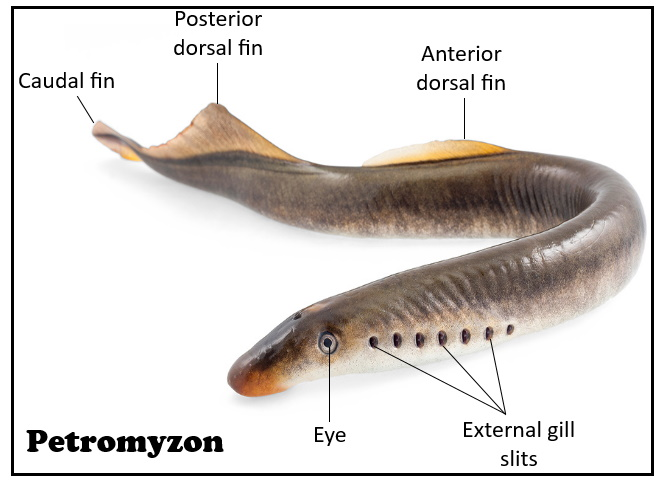
Which of the following jawless fish lays eggs in freshwater and its ammocoetes larvae after metamorphosis return to the ocean?
(a) Petromyzon
(b) Eptatretus
(c) Myxine
(d) Neomyxine
Answer
580.8k+ views
Hint: These jawless fishes have an eel-like body without paired fins. They have a long, greenish- brown, cylindrical body with smooth scaleless, slimy skin. They are also called the lamprey.
Complete answer:
Petromyzon is the jawless fish that lays eggs in freshwater and its ammocoetes larvae after metamorphosis return to the ocean. It belongs to the Class-Cyclostomata of Phylum- Chordata, and subphylum-Vertebrata. Their mouth is jawless, round and sucker-like, and as wide or wider than the head with sharp teeth arranged in many consecutive circular rows. There are 7 gill- like openings behind the eye.
Petromyzon migrates up rivers to spawn. In the substrate of streams with the moderately strong current nests are made by males in which females deposit a large number of eggs. The eggs hatch in about 3 weeks into minute transparent larvae called ammocoetes. Spawning is followed by the death of the adults. Larvae burrow in the sand and silt bottom in quiet water downstream from spawning areas and filter- feed on plankton and detritus.
After spending several years in freshwater habitats, the larvae undergo a metamorphosis that allows young, post-metamorphic lampreys to migrate to the sea or lakes, and start the adult hematophagous method of feeding. Some individuals start hematophagous feeding in the river before migrating to the sea, where sea lampreys prey on a wide variety of fish.
The lamprey uses its suction cup- like mouth to attach itself to the skin of a fish and rasps away tissue with its sharp, probing tongue and keratinized teeth. A fluid produced in the lamprey's mouth, called lamphredin, prevents the victim's blood from clotting. Victims typically die from excessive blood loss or infection. After one year of hematophagous feeding, lampreys return to the river to spawn and die, a year and a half after the completion of metamorphosis.

So, the correct answer is, ’Petromyzon’.
Note:
- Lampreys are considered a delicacy in some parts of Europe and are seasonally available in France, Spain, and Portugal. They are served pickled in Finland.
- Due to its lifecycle that switches between fresh and saltwater, the sea lamprey is adapted to tolerate a wide range of salinities. Cell membranes on the surface of the gills are major contributors to ion regulation.
Complete answer:
Petromyzon is the jawless fish that lays eggs in freshwater and its ammocoetes larvae after metamorphosis return to the ocean. It belongs to the Class-Cyclostomata of Phylum- Chordata, and subphylum-Vertebrata. Their mouth is jawless, round and sucker-like, and as wide or wider than the head with sharp teeth arranged in many consecutive circular rows. There are 7 gill- like openings behind the eye.
Petromyzon migrates up rivers to spawn. In the substrate of streams with the moderately strong current nests are made by males in which females deposit a large number of eggs. The eggs hatch in about 3 weeks into minute transparent larvae called ammocoetes. Spawning is followed by the death of the adults. Larvae burrow in the sand and silt bottom in quiet water downstream from spawning areas and filter- feed on plankton and detritus.
After spending several years in freshwater habitats, the larvae undergo a metamorphosis that allows young, post-metamorphic lampreys to migrate to the sea or lakes, and start the adult hematophagous method of feeding. Some individuals start hematophagous feeding in the river before migrating to the sea, where sea lampreys prey on a wide variety of fish.
The lamprey uses its suction cup- like mouth to attach itself to the skin of a fish and rasps away tissue with its sharp, probing tongue and keratinized teeth. A fluid produced in the lamprey's mouth, called lamphredin, prevents the victim's blood from clotting. Victims typically die from excessive blood loss or infection. After one year of hematophagous feeding, lampreys return to the river to spawn and die, a year and a half after the completion of metamorphosis.

So, the correct answer is, ’Petromyzon’.
Note:
- Lampreys are considered a delicacy in some parts of Europe and are seasonally available in France, Spain, and Portugal. They are served pickled in Finland.
- Due to its lifecycle that switches between fresh and saltwater, the sea lamprey is adapted to tolerate a wide range of salinities. Cell membranes on the surface of the gills are major contributors to ion regulation.
Recently Updated Pages
A man running at a speed 5 ms is viewed in the side class 12 physics CBSE

State and explain Hardy Weinbergs Principle class 12 biology CBSE

Which of the following statements is wrong a Amnion class 12 biology CBSE

Two Planoconcave lenses 1 and 2 of glass of refractive class 12 physics CBSE

The compound 2 methyl 2 butene on reaction with NaIO4 class 12 chemistry CBSE

Bacterial cell wall is made up of A Cellulose B Hemicellulose class 12 biology CBSE

Trending doubts
What are the major means of transport Explain each class 12 social science CBSE

Which are the Top 10 Largest Countries of the World?

Draw a labelled sketch of the human eye class 12 physics CBSE

State the principle of an ac generator and explain class 12 physics CBSE

Sketch the electric field lines in case of an electric class 12 physics CBSE

Give 10 examples of unisexual and bisexual flowers




